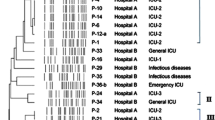Abstract
The intestinal colonization byEnterobacter cloacae strains with a derepressed cephalosporinase was studied in a paediatric ward between February 1990 and January 1991. Environmental sampling was performed simultaneously. Fifty-two isolates were recovered from 200 neonates (stool, blood) and 14 strains were isolated from the neonatal environment. An epidemiological study based on the typing of 36Enterobacter cloacae isolates was carried out using antibiotyping, biotyping and ribotyping methods. The isolates selected were from 21 neonates (24 isolates), the neonatal ward environment (8 isolates) and from other wards (4 isolates). Thirty-two isolates had the same antibiotic resistance pattern, corresponding to a derepressed cephalosporinase and resistance to the following aminoglycosides: kanamycin, gentamicin, tobramycin and netilmicin. No predominant biotyping pattern could be established. Ribotyping done with two endonucleases (EcoRI andBamHI) showed 28Enterobacter cloacae isolates to have a single pattern. Ribotyping was the most discriminating method used in this study, permitting identification of cross-contamination withEnterobacter cloacae in the paediatric ward.
Similar content being viewed by others
References
Spritzer R, Kamp H, Dzoljic G, Sauer P: Five years of cefotaxime use in a neonatal intensive care unit. Pediatric Infectious Disease Journal 1990, 9: 92–96.
Bryan CS, John JF Jr, Pai MS, Austin TL: Gentamicin versus cefotaxime for therapy of neonatal sepsis. American Journal of Diseases of Children 1985, 139: 1086–1089.
Andersen BM, Sorlie D, Hotvedt R: Multiply beta-lactam resistantEnterobacter cloacae infections linked to the environmental flora in a unit of cardiothoracic and vascular surgery. Scandinavian Journal of Infectious Diseases 1989, 21: 181–191.
Flynn DM, Weinstein RA, Nathan C, Gaston MA, Kabins SA: Patients' endogenous flora as the source of “nosocomial”Enterobacter in cardiac surgery. Journal of Infectious Diseases 1987, 156: 363–368.
Johnson MP, Ramphal R: Beta-lactam-resistantEnterobacter bacteriemia in febrile neutropenic patients receiving monotherapy. Journal of Infectious Diseases 1990, 162: 981–983.
McConkey SJ, Coleman DC, Falkiner FR, McCann SR, Daly PA:Enterobacter cloacae in a haematology/oncology ward. First impressions. Journal of Hospital Infection 1989, 14: 277–284.
Modi N, Damjanovic V, Cooke RWI: Outbreak of cephalosporin resistantEnterobacter cloacae infection in a neonatal intensive care unit. Archives of Disease in Childhood 1987, 62: 148–151.
Gaston MA:Enterobacter, an emerging nosocomial pathogen. Journal of Hospital Infection 1988, 11: 197–208.
Gaston MA, Bucher C, Pitt TL: O Serotyping scheme forEnterobacter cloacae. Journal of Clinical Microbiology 1983, 18: 1079–1083.
Gaston MA: Isolation and selection of a bacteriophage-typing set forEnterobacter cloacae. Journal of Medical Microbiology 1987, 24: 285–290.
Daw MA, Corcoran GB, Falkiner FR, Keane CT: Application and assessment of cloacin typing ofEnterobacter cloacae. Journal of Hospital Infection 1992, 20: 141–151.
Wang CC, Chu ML, Ho LJ, Hwang RC: Analysis of plasmid pattern in paediatric intensive care unit outbreaks of nosocomial infection due toEnterobacter cloacae. Journal of Hospital Infection 1991, 19: 33–40.
Richard C: Une méthode simple de marquage épidémiologique: la biotypie, application àEnterobacter cloacae etEscherichia coli. Bulletin de l'Association des Anciens Élèves de l'Institut Pasteur 1981, 87: 14–21.
Grimont F, Grimont PAD: Ribosomal nucleic acid gene restriction patterns as potential taxonomic tools. Annales de l'Institut Pasteur/Microbiology 1986, 137B: 165–175.
Grimont F, Chevrier D, Grimont PAD, Lefevre M, Guesdon JL: Acetylaminofluorene-labelled ribosomal RNA for use in molecular epidemiology and taxonomy. Research in Microbiology 1989, 140: 447–454.
Garaizar J, Kaufmann ME, Pitt TL: Comparison of ribotyping with conventional methods for the type identification ofEnterobacter cloacae. Journal of Clinical Microbiology 1991, 29: 1303–1307.
Grimont F, Grimont PAD: DNA fingerprinting. In: Stackebrandt E, Goodfellow M (ed): Nucleic acid techniques in bacterial systematics. J. Wiley, Chichester, 1991, p. 249–279.
Bingen E, Lambert-Zechovsky N, Leluan G, Desvignes A: Influence de l'ampicilline associée aux aminosides sur l'ecosystème bactérien intestinal de l'enfant. Annales Pharmaceutiques Françaises 1982, 40: 269–280.
Tullus K, Burmann LG: Ecological impact of ampicillin and cefuroxime in neonatal units. Lancet 1989, i: 1405–1407.
Tullus K, Berglund B, Fryklund B, Kuhn I, Burman LG: Epidemiology of fecal strains of the familyEnterobacteriaceae in 22 neonatal wards and influence of antibiotic policy. Journal of Clinical Microbiology 1988, 26: 1166–1170.
Nauciel C, Philippon A, Ronco E, Pilliot J, Guenounou M, Paul G, Brunel D, Outin HD: Septicémies àEnterobacter cloacae etEnterobacter aerogenes. Émergence de variants résistants (céphalosporinase déréprimée) en cours de traitement par des céphalosporines de troisième génération. La Presse Médicale 1985, 14: 673–676.
Gaston MA, Crees Morris JA, Pitt TL: Serotypes and biochemical profiles of British hospital strains ofEnterobacter cloacae in relation to site of infection and antibiotic susceptibility. Journal of Hospital Infection 1987, 10: 17–27.
Irino K, Grimont F, Casin I, Grimont PAD, andthe Brazilian Purpuric Fever Study Group: rRNA gene restriction patterns ofHaemophilus influenzae biogroupAegyptius strains associated with Brazilian purpuric fever. Journal of Clinical Microbiology 1988, 26: 1535–1538.
Bingen E, Denamur E, Lambert-Zechkovsky N, Brahimi N, El Lakany M, Elion J: Rapid genotyping shows the absence of cross-contamination inEnterobacter cloacae nosocomial infections. Journal of Hospital Infection 1992, 21: 95–101.
Verschragen G, Claeys G, Delanghe M, Pattyn P: Serotyping and phage typing to identifyEnterobacter cloacae contaminating total parenteral nutrition. European Journal of Clinical Microbiology and Infectious Diseases 1988, 7: 306–307.
Reybrouck G: Role of the hands in the spread of nosocomial infections. Journal of Hospital Infection 1983, 4: 103–110.
Kjolen H, Andersen BM: Handwashing and disinfection of heavily contaminated hands: effective or in-effective? Journal of Hospital Infection 1992, 21: 61–71.
Author information
Authors and Affiliations
Rights and permissions
About this article
Cite this article
Poilane, I., Cruaud, P., Lachassinne, E. et al. Enterobacter cloacae cross-colonization in neonates demonstrated by ribotyping. Eur. J. Clin. Microbiol. Infect. Dis. 12, 820–826 (1993). https://doi.org/10.1007/BF02000401
Issue Date:
DOI: https://doi.org/10.1007/BF02000401



